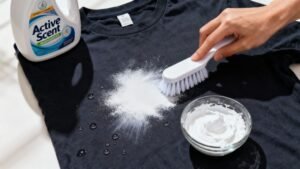
How to Clean Mildew Smell from Clothes
That stubborn, musty smell clinging to your clothes isn't just dampness—it's the signature scent of mildew, a clear sign that mold and fungi have made a home in the fabric. Simply re-washing the load rarely works. To truly eliminate the odor, you have to get to the source with a pre-treatment of vinegar or baking soda, followed by a cycle in the hottest water the garment can safely handle.
This one-two punch is designed to kill the microscopic spores causing the problem, creating a perfectly clean slate for a luxury detergent to work its magic.
What Causes That Stubborn Mildew Smell in Clothes?
We’ve all been there. You open the washer expecting fresh, clean laundry, but instead, you're hit with that unmistakable earthy, musty scent. It's a frustrating moment, and it’s a sign of a microbial takeover. It’s not just a smell; it's a living colony thriving deep within the fibers of your favorite clothes.
The Science Behind the Scent
So, what’s really going on? That distinct mildew odor is the byproduct of mold and fungal spores. These tiny organisms flourish in environments that are damp, warm, and lack good air circulation—exactly like a pile of wet towels or a forgotten load of laundry left in the machine overnight.
As these spores multiply, they release metabolic compounds that create that potent, musty smell. Because these compounds penetrate deep into the fabric, the odor stubbornly lingers even after you've run a standard wash cycle.
Key Takeaway: That mildew scent isn't just leftover dampness. It's the result of active microbial growth within the fabric's fibers. You have to kill the source, not just mask the odor.
Why Your Usual Wash Cycle Fails
Tossing the clothes back in with a regular detergent often feels like a waste of time and energy. There are two main reasons for this. First, the spores themselves are surprisingly resilient. But more often than not, the real culprit is your washing machine.
Believe it or not, washing machines are prime breeding grounds for tough microbial biofilms, especially in hidden spots like the rubber door seal and the detergent dispenser. These slimy layers can survive high temperatures and the agitation of a wash cycle.
This means your machine might actually be re-introducing mold spores onto your "clean" clothes with every wash. It's a frustrating cycle of contamination. If this sounds familiar, our guide on how to remove odors from your washing machine can help you break the cycle.
By tackling both the fabric and the machine, you create the clean foundation needed for a truly fresh and luxurious laundry experience—one where a premium, beautifully scented product can finally perform at its best.
Your Pre-Wash Strategy for Odor Elimination
A powerful wash cycle needs a smart opening act. Before a luxury detergent can infuse your clothes with its signature scent, you have to neutralize those embedded mildew odors right at the source. Trust me, just tossing musty clothes into the machine is a recipe for disappointment. The real battle is won in the pre-wash.
This is the crucial first step that prepares the fabric, creating a clean slate for your detergent to add a touch of boldness and a surge of confidence. Without it, even the most exquisite fragrances are just fighting an uphill battle against deeply rooted fungal compounds. Here's your playbook for success.
Harnessing Household Staples
You don't need harsh chemicals to get started. In fact, two of the most effective tools for banishing that mildew smell are probably already in your pantry: white vinegar and baking soda. These simple but potent ingredients work on a chemical level to break down the very source of the odor.
- White Vinegar: The acetic acid is the star here. It penetrates deep into fabric fibers to break down the alkaline compounds that create that signature musty smell. It also acts as a natural disinfectant and softener.
- Baking Soda: Think of this as a powerful odor magnet. It works by neutralizing the pH of acidic odor molecules, essentially erasing them from the fabric for good.
A pre-soak is, by far, the most effective way to use them. It lets these ingredients fully saturate the material and go to work before the main wash cycle even kicks off.
The Perfect Pre-Soak Method
First things first: separate the affected garments to prevent any cross-contamination. You don't want that smell spreading. For a standard load of musty clothes, a quick 30-minute soak is often all you need to make a huge difference.
One of the most effective, tried-and-true methods involves a simple ratio. Soaking clothes for 30 minutes in a solution of one part white vinegar to two parts water can dramatically reduce musty odors. You can also give your main wash a boost by adding a half-cup of baking soda, which can improve odor reduction by up to 75%. For more on these techniques, check out the great tips on Whirlpool.com.
Pro Tip: Never, ever mix vinegar and bleach—it creates toxic chlorine gas. For safety and effectiveness, stick to one pre-treatment method at a time.
This approach is especially critical for items that really hold onto odors, like gym clothes. The same principles that remove mildew from a forgotten towel are just as powerful on other stubborn smells. You can learn more in our guide on how to get the smell out of workout clothes.
By prepping your clothes properly, you ensure every garment is truly ready to be infused with a clean, sophisticated fragrance—not just have one masked on top.
Crafting the Perfect Wash Cycle for Freshness
You’ve pre-treated your clothes, which is a great start. But now comes the main event: the wash cycle that will completely knock out any lingering mildew spores and the musty smell they leave behind. This isn't just about tossing everything in and hoping for the best. It's about being strategic.
Think of this step as purifying the fabric. You're creating a truly clean, neutral foundation so it can become the perfect canvas for a bold, mysterious, and hypnotic scent.
Harnessing the Power of Hot Water
When you're fighting mildew, heat is your best friend. Those stubborn spores might be resilient, but they simply can’t survive high temperatures.
For durable fabrics like cotton towels, sheets, and tough synthetics, go for the hot cycle without a second thought. This intense heat does more than just kill the mildew; it also dissolves any oils or dirt the spores use as a food source.
But what about your more delicate items? Not everything can handle the heat, and that’s okay. A warm wash is your next best option, offering a much deeper clean than cold water without putting your favorite garments at risk. Always—always—check the care label first.
Choosing the Right Detergent and Cycle
Using a heavily perfumed detergent at this stage can actually work against you. It might seem like a good idea, but it often just masks the musty odor instead of truly eliminating it. You need pure, unadulterated cleaning power.
This is exactly why Active Scent's odor-free laundry detergent is the perfect choice. It has been carefully formulated for a deep and effective clean, without competing fragrances. It purifies your fabrics, creating the ultimate neutral base to perfectly complement our range of luxury scented fabric softeners. Powerful cleaning. Zero interference.
Once you’ve added the detergent, select a heavy-duty or long wash cycle. The extended agitation and soak time allows the detergent and hot water to work their way deep into the fabric fibers, ensuring a complete, inside-out cleanse.
Expert Tip: Don't cram the washing machine. Your clothes need room to tumble and agitate freely. A packed machine traps dirt and mildew spores, leading to an incomplete clean and defeating the whole purpose.
Of course, knowing the fundamentals of laundry care is always a bonus. For some excellent general advice, check out these tips on how to wash underwear effectively.
To help you get the settings just right, here’s a quick guide for common fabrics.
Optimal Wash Settings for Different Fabric Types
This table is your cheat sheet for choosing the perfect water temperature and cycle. Getting it right is key to killing mildew without damaging your clothes.
| Fabric Type | Recommended Water Temperature | Recommended Wash Cycle | Special Considerations |
|---|---|---|---|
| Cotton (Towels, Sheets) | Hot (130°F / 54°C or higher) | Heavy-Duty or Sanitize | Can handle high heat well, which is ideal for killing spores. |
| Polyester & Blends | Warm to Hot | Normal or Permanent Press | A durable synthetic, but check the label. Our guide on how to clean polyester has more tips. |
| Delicates (Silk, Lace) | Cool or Warm (Never Hot) | Delicate or Hand Wash | High heat will cause damage. Rely on the pre-treatment and detergent. |
| Activewear | Warm | Activewear or Synthetics | Avoid fabric softener in this step as it can trap odors in technical fabrics. |
Matching the cycle to the fabric ensures you're treating the mildew as aggressively as possible while still respecting the material.
Creating the Perfect Scent Canvas
By following this method—a hot or warm wash with a powerful, fragrance-free detergent—you’re doing so much more than just cleaning your laundry. You are curating a pristine, neutral canvas. This is the real secret to unlocking a true luxury fragrance experience.
Once every trace of mildew is gone, the fabric is perfectly prepped to absorb and hold the complex notes of a high-end softener. Instead of a messy clash of scents, you get a clean, pure infusion. This allows the sophisticated aromas of an Active Scent fabric softener—inspired by iconic French houses like Dior, Mugler, Chanel, and Le Labo—to truly stand out, leaving an unforgettable olfactory statement.
The Art of Drying: Locking in a Luxurious Scent
The wash cycle is only half the story. The real artistry happens in the final step: drying. This is where you lock in all that hard-earned freshness and build your final defense against mildew's return. Leaving even a hint of moisture is an open invitation for musty odors to creep back in.
This final stage is your chance to elevate the entire experience. After purifying your garments with Active Scent’s powerful odor-free detergent, the drying phase is where you can layer a sophisticated, lasting fragrance. You’re not just doing laundry; you're creating a true sensory statement that leaves a lasting impression.
Embrace the Power of Natural Sunlight
Whenever you can, let nature handle the final touches. Line-drying clothes in direct sunlight is more than just an eco-friendly choice; it's an incredibly effective way to ensure every last mildew spore is gone for good.
The sun’s ultraviolet (UV) rays act as a natural disinfectant, breaking down any remaining odor compounds and neutralizing stubborn microbes. It’s an old-world secret that still works wonders.
This method is especially powerful for thick, absorbent items that love to hold onto damp, musty smells. If you've ever battled with stubborn odors, learning how to get towels to smell fresh often comes down to this simple, effective step. Just hang them with plenty of space for air to circulate, and let the sun work its magic.
A Quick Note on Sunlight and Color: While fantastic for whites and most durable fabrics, be mindful of prolonged sun exposure on dark or brightly colored garments. Over time, it can cause some fading.
Master the Machine Dryer
For those days when line-drying just isn't happening, your machine dryer is a powerful ally—if you know how to use it right. The goal is simple: get your clothes completely, bone-dry without scorching the fibers with excessive heat.
Here are a few tips I've picked up for getting the best results:
- Don't Stuff the Dryer: Just like in the wash, your clothes need room to tumble. An overloaded dryer traps moisture, leading to annoying damp spots and uneven drying. Give them space to breathe.
- Choose the Right Heat: Use the highest heat setting your fabric can safely handle. This ensures all moisture evaporates properly. For delicates, a lower temperature with a longer cycle is always the safer bet.
- Add Wool Dryer Balls: These are a game-changer. They bounce around, separating clothes so they dry faster, and they naturally soften fabrics and reduce static without any of the chemicals found in traditional dryer sheets.
Think of this step as completing the fragrance journey you started. You’ve already used Active Scent’s Odorless Detergent to create that perfectly pure, clean base. Now, a luxury scented fabric softener from the wash will have infused your clothes with hypnotic depth. Imagine deep, earthy patchouli fusing with the burning radiance of amber, or fiery pimento berries igniting the composition with spice and warmth. Your laundry won't just be clean; it will be an unforgettable olfactory experience.
You’ve won the battle against mildew—that fantastic feeling of fresh, clean laundry. But the real victory is making sure it never comes back.
This isn’t about endless deep-cleaning sessions. It’s about building small, almost effortless habits into your routine. These little rituals are what separate a reactive chore from the art of maintaining a perpetually fresh wardrobe. When you create an environment where mildew simply can’t thrive, the bold, mysterious fragrances you love can finally take center stage.
Master Your Laundry Routine
The most common culprit behind mildew is also the easiest to fix: leaving wet clothes sitting around. A pile of damp fabric, whether in the hamper or the washing machine, is a paradise for mold spores.
The golden rule is to move your clothes from the washer to the dryer immediately. Life gets busy, I know. If you think you might get held up, see if your machine has a "tumble fresh" setting. It’s a lifesaver, periodically tumbling the drum to keep air moving and buy you some time.
A Personal Tip: The moment I start a wash cycle, I set a timer on my phone. It’s such a simple thing, but it’s saved me from forgetting a load more times than I can count. Forgotten laundry is the number one way mildew sneaks back into your life.
Create an Environment of Freshness
Your closet and drawers are your next line of defense. Mildew loves stagnant, humid air, so good ventilation isn't just a nice-to-have; it's non-negotiable.
- Don't Overcrowd Your Closet: Your clothes need room to breathe. When they’re packed in tight, airflow stops, trapping any moisture from the air or even your body.
- Ensure Everything is Bone-Dry: Never, ever put away clothes that feel even slightly damp. That tiny bit of moisture is all mildew needs to get started in a dark, enclosed space.
- Consider a Dehumidifier: If you live in a humid climate or use a basement closet, a small dehumidifier is a game-changer. It creates an environment that's actively hostile to mold and mildew.
Maintain Your Washing Machine
Your washing machine can secretly harbor the very biofilms that cause those stubborn, musty odors. If the machine itself smells off, it’s going to transfer that scent right back onto your "clean" clothes, undoing all your hard work.
About once a month, run a dedicated cleaning cycle. You can use a specialty washing machine cleaner or just run a hot cycle with some white vinegar. For front-loaders, make it a habit to wipe down the rubber door seal after your last load and always leave the door slightly ajar. This lets the drum air out completely, preventing the dark, damp conditions where mildew thrives.
Keeping your machine pristine creates the perfect clean base. It allows a luxury softener, like one from Active Scent, to infuse your fabrics with its intended bold, unforgettable fragrance. Your laundry won't just be clean; it will become a lasting statement of refinement.
Your Top Mildew Questions, Answered
Even when you’ve got the process down, a few questions always seem to pop up when tackling that stubborn mildew smell. It’s completely normal. Let’s walk through some of the most common ones I hear, so you can refine your routine and keep your laundry smelling absolutely incredible.
Should I Just Use Bleach to Kill the Smell?
It’s tempting, I know. Reaching for chlorine bleach feels like the ultimate weapon, and for tough, durable whites like cotton towels or bedding, it can be a lifesaver.
But for almost everything else? It’s a huge risk. Bleach is notorious for causing permanent color fading and can even weaken the fibers of your favorite colored or delicate pieces. A vinegar pre-soak followed by a hot wash is a much safer bet—and trust me, it’s just as effective at eliminating the source of the odor. If you really feel like your colors need an extra kick, grab an oxygen-based bleach instead. It’s far gentler but still gets the job done.
My Front-Load Washer Always Smells Musty. Is That the Real Problem?
Yes, that’s almost certainly a huge part of it. A smelly washer is one of the biggest culprits behind musty laundry. That rubber door seal on a front-loader is a perfect little breeding ground for mildew and biofilm—it’s dark, damp, and traps moisture like nothing else. That gunk then transfers right onto your clothes with every single wash.
You have to break the cycle by making washer maintenance a non-negotiable habit. After you’re done with laundry for the day, give that rubber seal a quick wipe-down with a dry cloth. Most importantly, leave the machine door open to let the drum air out completely. Running a monthly cleaning cycle with a dedicated washer cleaner (or just a hot cycle with some vinegar) is also key to preventing that funky buildup in the first place.
Think of it this way: you can't create a masterpiece on a dirty canvas. A pristine machine gives you a truly clean start, ensuring the luxurious fragrance from Active Scent isn't just masking old odors but infusing perfectly purified fabric. Each product delivers a spark of joy and a surge of confidence.
I’ve Washed This Towel a Dozen Times, but the Smell Won’t Go Away!
Don’t throw in the towel just yet! They are incredibly absorbent by design, which means they hold onto moisture—and stubborn mildew spores—with a death grip. When a normal wash cycle isn’t cutting it, it’s time to bring out the big guns.
First, give that towel a long soak. I’m talking at least an hour in a basin of hot water with one part white vinegar to two parts water. After it's had a good soak, toss it in the wash on the absolute hottest setting the fabric can handle. Add your regular detergent and about a half-cup of baking soda directly into the drum.
Finally, dry it completely on high heat. Or even better, if you can, hang it in direct sunlight. The UV rays are fantastic for finishing off any lingering bacteria.
Won’t a Luxury Fabric Softener Just Cover Up the Smell?
This is a really common misconception, but it gets to the heart of what separates a temporary fix from a true sensory experience. Just pouring a gorgeous fragrance over a musty problem is like spraying perfume without showering first—it only creates a muddled, unpleasant scent.
True luxury is always built on a foundation of absolute cleanliness.
The whole point of the pre-treatments and specialized washing steps is to completely eradicate the mildew at its source. Once the fabric is purified with a powerful, fragrance-free detergent, it becomes the perfect, pristine canvas.
At that point, a luxury softener is no longer a cover-up. It's the final, artful touch that infuses those clean fibers with a sophisticated, bold, and unforgettable fragrance—a bold tribute to the spirit of renowned fragrance houses.
LAUNDRY NEVER SMELLED SO GOOD! Ready to transform laundry from a chore into a statement? Discover the bold, unforgettable fragrances of Active Scent and let yourself be seduced by a scent that leaves a lasting impression. Explore our collection today.










